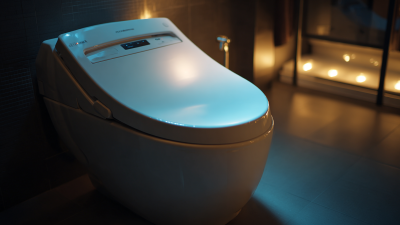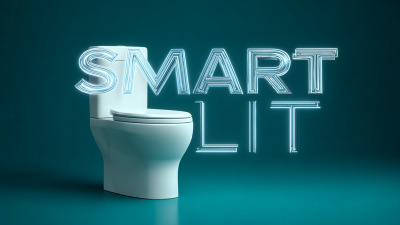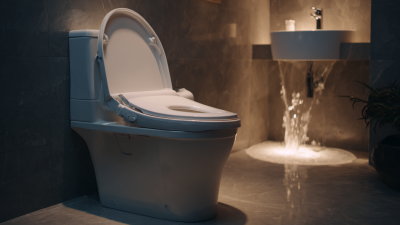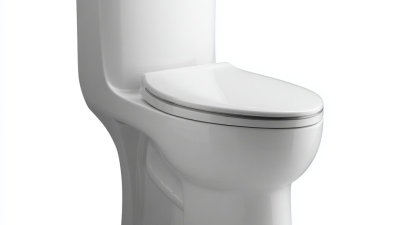Leave Your Message
As the global demand for smart home solutions continues to surge, the market for Electric Toilet Smart technology is becoming increasingly prominent. According to a recent report by Statista, the smart bathroom market is projected to grow from $7.6 billion in 2020 to over $10 billion by 2025, driven by advancements in connectivity and user-friendly features.
 The 138th China Import and Export Fair in 2025 will serve as a pivotal platform for showcasing these industry trends. This event not only highlights innovative products but also provides insights into consumer preferences and competitive strategies within the Electric Toilet Smart segment.
Companies are increasingly investing in IoT integration and sustainable designs, reflecting a broader shift towards eco-friendly technologies. As we explore the latest trends at this fair, it becomes evident that the convergence of technology and essential daily conveniences is reshaping the sanitation landscape and setting new standards for modern living.
The 138th China Import and Export Fair in 2025 will serve as a pivotal platform for showcasing these industry trends. This event not only highlights innovative products but also provides insights into consumer preferences and competitive strategies within the Electric Toilet Smart segment.
Companies are increasingly investing in IoT integration and sustainable designs, reflecting a broader shift towards eco-friendly technologies. As we explore the latest trends at this fair, it becomes evident that the convergence of technology and essential daily conveniences is reshaping the sanitation landscape and setting new standards for modern living.
The 138th China Import and Export Fair in 2025 is set to highlight the latest advancements in smart toilet technology, a sector experiencing rapid growth driven by rising consumer demand for health, comfort, and sustainability. According to a report by Research and Markets, the global smart toilet market is projected to reach USD 4.2 billion by 2027, with a CAGR of 10.2% from 2020 to 2027. This growth is primarily fueled by innovations that enhance user experience, such as integrated bidets, automatic cleaning features, and smart sensor technology, providing a hygienic solution that aligns with modern lifestyles.
Innovations showcased at the fair are expected to feature cutting-edge designs that incorporate IoT functionality, enabling users to connect their smart toilets to home automation systems. Furthermore, sustainability is at the forefront of these advancements, with manufacturers focusing on water-efficient models that reduce consumption without compromising performance. A recent study by Mordor Intelligence highlights that smart toilets can save up to 60% more water compared to traditional models, addressing both environmental concerns and cost-saving benefits. The convergence of technology and ecological awareness at the fair underscores a significant trend—consumers are increasingly prioritizing products that enhance their quality of life while also being mindful of their ecological footprint.

At the 138th China Import and Export Fair in 2025, industry leaders in electric toilet smart solutions are placing a significant emphasis on sustainability. As the demand for eco-friendly products rises, manufacturers are responding by innovating technologies that reduce water consumption and energy use. These advancements not only contribute to a lower environmental impact but also enhance the overall user experience by integrating smarter, more efficient features.

Industry experts stress the importance of sustainable materials in the production of electric toilets. This focus on eco-friendly manufacturing processes ensures that products meet the growing consumer demand for greener options. Additionally, partnerships with environmental organizations highlight the industry's commitment to social responsibility and sustainability.
Insights shared at the fair will undoubtedly influence future trends and push towards a collective goal of creating electric toilets that prioritize environmental consciousness without compromising on quality or innovation.
In recent years, consumer preferences have shifted significantly towards smart toilet features, reflecting a growing demand for advanced technology in everyday sanitation products. According to a 2023 report by Global Market Insights, the smart toilet market is projected to surpass $4 billion by 2027, driven by increasing urbanization and heightened awareness regarding hygiene. Consumers now prioritize functionalities such as bidet features, automatic cleaning, and user-friendly interfaces that enhance the overall bathroom experience.
Tips: When choosing a smart toilet, consider features that match your lifestyle. Look for models with customizable settings for water temperature, pressure, and even air drying, as these can dramatically improve user satisfaction. Moreover, energy-efficient designs are gaining traction, offering eco-friendly options that reduce waste without compromising comfort.
With the 138th China Import and Export Fair set to showcase the latest innovations, brands are expected to highlight how their smart toilets align with evolving consumer preferences. Features like smartphone connectivity and voice-controlled options are becoming standard, appealing to tech-savvy consumers seeking convenience in their daily routines. As manufacturers adapt to these trends, we are likely to see a wider range of products that cater to both luxury and practicality.
The rapid advancement in smart technology has significantly influenced the electric toilet industry, particularly as manufacturers prepare for the upcoming 138th China Import and Export Fair in 2025. Regulatory guidelines play a critical role in shaping the design and functionality of these innovative products. Authorities are increasingly focusing on health, safety, and sustainability standards, prompting companies to enhance their appliances accordingly. Regulations concerning energy efficiency and water conservation are becoming more stringent, driving designers to create smart toilets that not only provide convenience but also minimize environmental impact.
In addition to environmental regulations, user accessibility standards are gaining traction. As populations age and diverse user needs arise, the design of electric toilets must accommodate various physical capabilities. This includes ergonomic features and intuitive interfaces to ensure usability for all consumers. Compliance with these regulatory frameworks not only boosts consumer confidence but also encourages technological innovation, leading to an overall improvement in the functionality and appeal of electric toilet smart solutions at the fair. As industry players navigate these evolving regulations, they will likely emerge more competitive in a rapidly changing marketplace.
| Feature | Regulatory Requirement | Impact on Design | Expected Consumer Demand |
|---|---|---|---|
| Smart Flushing System | Water conservation regulations | Integrated sensors for efficient water use | High |
| Temperature Control | Safety standards for electrical appliances | Auto shut-off features and insulation materials | Medium |
| Self-Cleaning Function | Health and hygiene regulations | Use of antimicrobial materials and UV sanitization | Very High |
| Mobile App Integration | Data privacy regulations | Enhanced encryption and user control settings | High |
| Energy Efficiency | Energy conservation regulations | Implementation of energy-saving technologies | Medium |
As we delve into the future of modern homes,
electric toilets are emerging as a key innovation that promises to intertwine
comfort,
hygiene,
and efficiency. According to a report by Research Nester, the global
smart toilet market
is expected to reach USD 6 billion by 2025, highlighting a growing
consumer preference for high-tech solutions that enhance bathroom experiences.
Electric toilets, equipped with features like bidet functions, heated seats,
and automated cleaning, are revolutionizing the way we perceive and use sanitation facilities.
Tips for integrating electric toilets into your home include evaluating your
plumbing system compatibility and understanding the specific features that
cater to your needs. Consider models with built-in deodorizing functions and
adjustable water temperatures for enhanced comfort. Furthermore, don’t overlook
energy efficiency; many modern electric toilets
are designed to reduce water usage without compromising performance, aligning
with sustainable living practices that are gaining traction among homeowners.
Incorporating electric toilets not only elevates the aesthetic of your bathroom
but also significantly contributes to overall hygiene. The convenience of hands-free
operation and advanced cleaning mechanisms offers an unparalleled experience that
resonates with today’s health-conscious consumers. As cities evolve and housing
structures modernize, the presence of electric toilets will undoubtedly become a
staple in contemporary living spaces, reshaping the definition of bathroom luxury.






